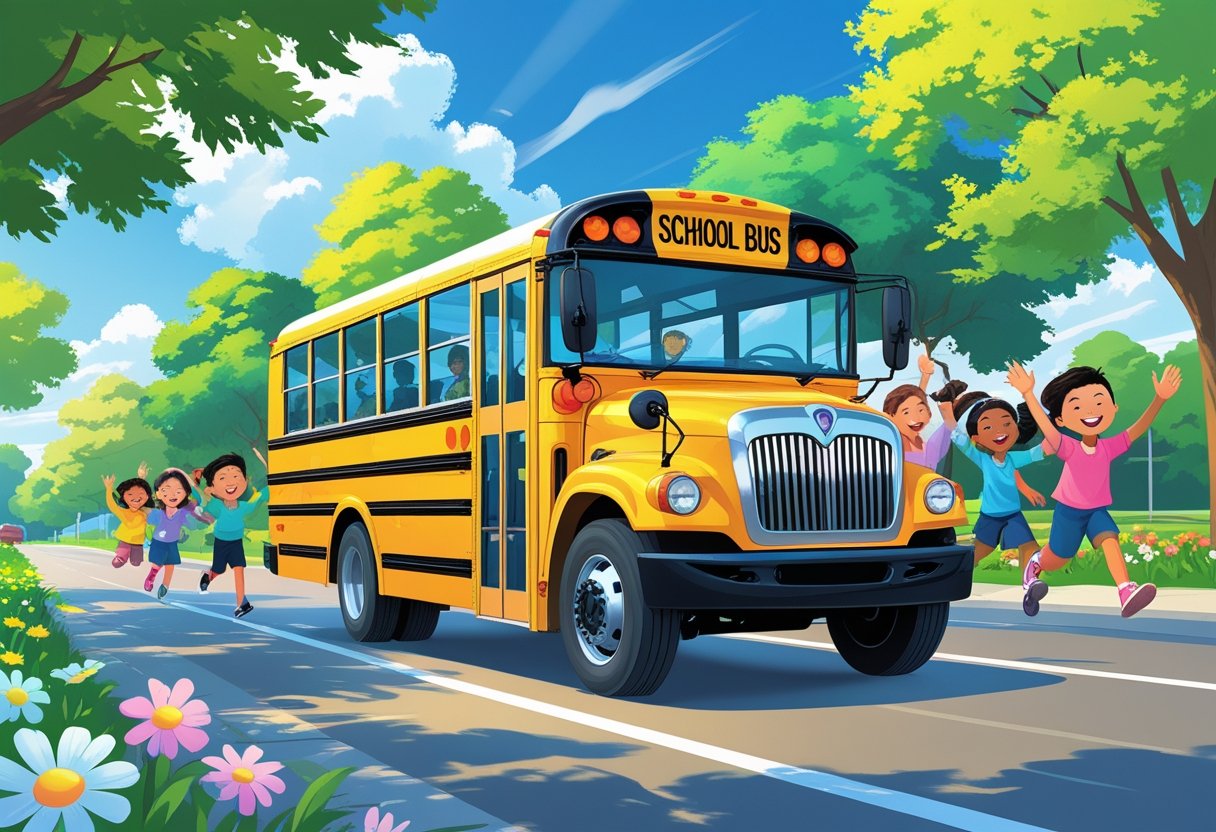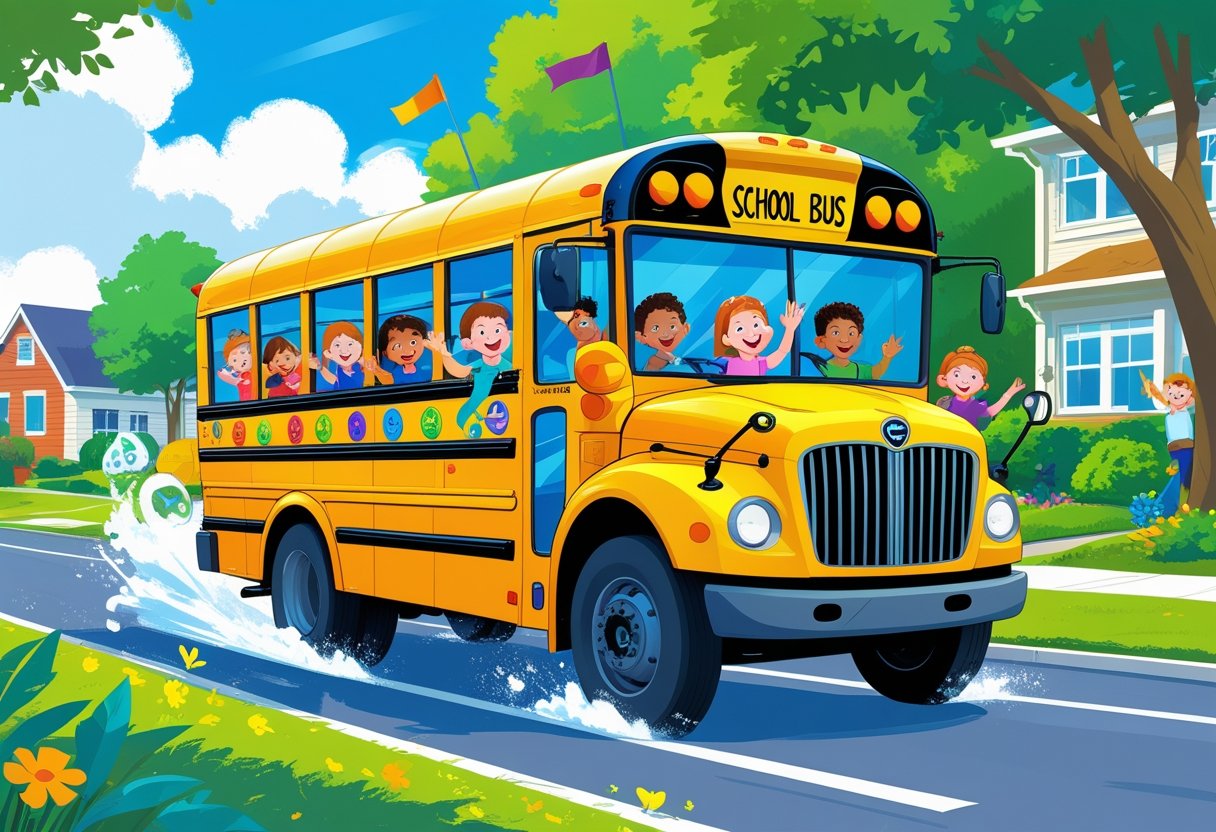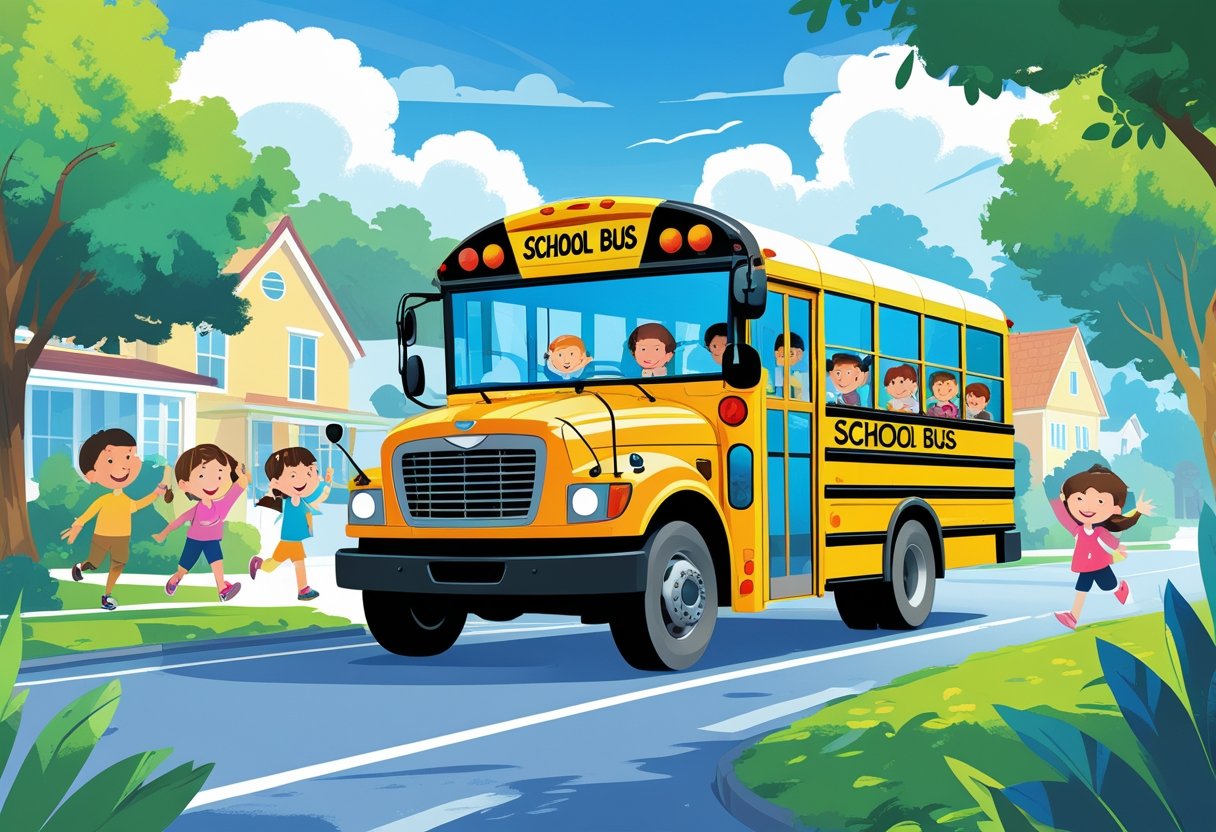If you’re looking for a simple way to enjoy the classic children’s song, “The Wheels on the Bus,” having printable lyrics can be really handy. The wheels on the bus printable lyrics make it easy to sing along, learn the words, and share the song with little ones anytime. Whether you’re teaching kids at home or in a classroom, having the words in front of you helps everyone join in.

I remember the first time I used printable lyrics for “The Wheels on the Bus” by Verna Hills—it made the song so much more fun and accessible to the children. The words are repetitive and easy to follow, which is why this song has been loved by kids for years. You can find versions that highlight each part, like the wheels, wipers, and doors, which makes it great for learning and play.
If you want a handy and clear set of lyrics to use for singing, sharing, or even printing out colourful sheets, there are plenty available online that fit just right. It’s a simple resource that brings the song to life and keeps little singers engaged every time the wheels go round and round. You can explore printable options that suit your needs, making storytime or playtime even better. For example, you can find free printable lyrics at sites like LearnEnglish Kids.
Wheels on the Bus Lyrics Overview

The song uses simple, repetitive lines that are easy to remember and fun to sing. Each part describes a different action on a bus, creating a familiar and playful rhyme. The rhythm and words help young children learn through music and movement.
Complete Lyrics Breakdown
The most common verse is “The wheels on the bus go round and round, round and round, round and round.” This line sets up the pattern. Other verses include “The wipers on the bus go swish, swish, swish,” and “The horn on the bus goes beep, beep, beep.” Each verse focuses on a part of the bus or something it does.
The song usually repeats these phrases with slight changes, which helps kids follow along. Some versions add extra verses about doors opening and closing or the people on the bus. I find it useful to have the full lyrics printable for easy access, like this free lyrics PDF.
Key Verses and Phrases
The most memorable phrase is the wheels going “round and round.” It shows the bus moving, which is easy for children to picture. Other key lines involve sounds, such as “beep, beep, beep” or actions like “the wipers go swish, swish, swish.” These sounds invite kids to join in with noise and movement.
Using simple verbs like “go” keeps the song clear and easy to repeat. The rhyme and rhythm make it fun but also educational. This song was written by Verna Hills and has become part of American childhood traditions, spreading worldwide due to its catchy design.
Significance of Repetition in the Song
Repetition is the heart of this song. Saying “round and round” or “swish, swish, swish” again and again helps children remember the words. It also encourages participation by making the song predictable. This kind of repetition supports language development and listening skills.
Because the song repeats short phrases, kids can easily join in after hearing it a few times. This builds confidence and makes learning fun. The repetitive structure is a key reason it works well as a learning tool, helping children focus on sounds and actions linked to the words.
Printable Versions of Wheels on the Bus Lyrics

I’ve found that having printable versions of the Wheels on the Bus lyrics really helps when teaching or entertaining kids. You get clear, easy-to-read song lyrics that you can take anywhere, especially when you need to sing along or play music without relying on a screen.
Types of Printables Available
There are several types of printables you can find for the Wheels on the Bus song. The most common are simple lyric sheets, which just list the song lyrics in a clear font.
Some printables come with illustrations or colouring pages featuring the bus or characters from the song. Others might include song sticks, which are small cards with parts of the lyrics, used to help kids follow along or join the singing.
In addition, many printables offer a karaoke-style layout where the words are spaced out for easier reading during singing.
Where to Access Free Printables
Finding free printables is easy if you know where to look. Websites like DLTK-Teach offer clear, printable song lyrics suited for young children.
You can also get printable versions with little extras, like colouring pages or song sticks, from teaching blogs that focus on preschool and kindergarten activities.
If you want a simple PDF that’s ready to print, sites such as Singing Bell have downloadable options that don’t require you to sign up or pay anything.
Tips for Printing at Home
When printing the lyrics at home, I always check the print preview first to make sure the full song fits on the page clearly.
Using a good quality printer can make a difference, especially if the printable has images or colours. I prefer printing on slightly thicker paper so the pages last longer with little hands handling them.
If you want to make the printout more durable, you can laminate the pages or put them into plastic sleeves to use again and again during circle time or outings.
Popular Song Actions and Motions
I find that adding simple actions to this song really helps children join in and remember the words. Most of the motions match the sounds or movements in the verses, like wheels going round or a horn beeping. Using these actions keeps the song fun and interactive for young learners.
Actions for Verses
Each verse has a matching action that makes the words come to life. For example:
- Wheels go round and round — you can move your hands or arms in circles.
- Wipers swish, swish, swish — hold your hands out flat and move them side to side.
- Horn goes beep, beep, beep — tap your fingers on your arm or pretend to beep a horn.
- Doors open and shut — open and close your hands like a door.
Other sounds like shush or wah are great for finger gestures too. It’s also fun to add clapping or tapping to sounds like clink, clink, clink or ding, ding, ding. These simple movements help children understand what each sound means.
Incorporating Movement with Lyrics
I like to match the movements closely to the words so kids can feel what’s happening in the song. When singing round and round, spinning in place gently or swirling your arms helps. For shush, shush, shush, putting your finger to your lips works well.
Using actions like pretending to be a baby going wah, wah, wah or miming reading for daddies go read, read, read makes the song more lively. You can also add a little marching in place or tapping feet to keep the rhythm going. This mix of motion and words helps keep children focused and active during the song.
If you want a ready-made version with printed actions and lyrics, you can find a good example of a printable version with these motions here: The Wheels On The Bus Song Lyrics Printable.
Exploring the Characters and Elements on the Bus
When I think about the bus in the song, I picture the different people and actions that make the ride lively and fun. Each character has a special role, from the person who drives the bus to the youngest passengers and their parents. The simple events on the bus help tell a story everyone can understand.
Driver, People, and Children
The driver on the bus is the one who keeps everything moving. I imagine them saying, “move on back” to tell people where to sit. Their role feels important because they make sure the bus goes all through the town safely.
There are also many people on the bus. Some might be chatting or looking out the window. The children are very active, with their actions like laughing or shouting “wah, wah, wah” showing how noisy and full of energy the bus can be.
The people and children together create a lively scene. Their movements and sounds add fun and excitement to the journey, which is why this part of the song stands out to me.
Baby and Mommies on the Bus
The baby on the bus is easy to spot because of the crying sound. This part makes the song feel closer to real life, where babies’ needs and noises are a natural part of any bus journey.
The mommies on the bus help calm their babies, showing care and comfort. This gentle scene balances the energetic parts made by the driver and children.
I like how the song captures these quiet moments alongside the louder ones, giving a good mix of what you might see and hear on a real bus. It shows that even small details, like a baby’s cry or a mother’s soothing voice, are part of the daily bus ride experience.
For the full set of lyrics and to print your own version, you can check a wheels on the bus lyrics printable.
Distinctive Sounds and Motions in the Song
I love how the song brings the bus to life by describing sounds and movements you can easily act out. The noises like the wipers swishing or the horn beeping make it fun to sing along. Each sound matches a simple gesture, making it an easy way to get children involved.
Wipers, Horn, and Doors
The wipers on the bus go swish, swish, swish. You can move your hands side to side to show this motion, just like real windscreen wipers clearing the rain. It’s a gentle, repetitive sound that kids enjoy copying.
Next, the horn on the bus goes beep, beep, beep. This is a short, sharp noise, and you can mimic it by pressing an imaginary button. It adds excitement to the song and breaks up the softer wiper sounds.
The doors on the bus go open and shut. For this, you push your hands forward and pull them back, pretending to open and close the door. It’s a very clear action, easy to imitate, helping children understand how the doors work.
Other Notable Sounds
Besides the wipers, horn, and doors, the song also mentions the babies on the bus saying wah, wah, wah. This sound brings in a realistic moment of the baby crying, which kids can mimic by making the same sound with their mouth.
There’s also a ding or clink sound related to the money or tickets, which is less common but adds variety. Lastly, the song sometimes uses shush to show quiet moments, encouraging children to whisper or hush softly.
These small sounds and actions make the song interactive and engaging, perfect for singing and playing at the same time. For printable lyrics and more ideas, you can check out the The Wheels On The Bus lyrics PDF.
History and Cultural Impact of Wheels on the Bus
The story of Wheels on the Bus connects to earlier children’s songs and reflects changes in American childhood over time. Its simple tune and repetitive style made it easy to learn and remember, helping it spread quickly.
Origins of the Song
Wheels on the Bus was first published in 1937 and is often credited to Verna Hills, who lived into her nineties. The song likely grew from earlier traditional tunes like Here We Go Round the Mulberry Bush. Both songs use repetitive, circular patterns that make singing easy for kids.
I find it interesting that Wheels on the Bus captures everyday things children see, like wheels turning and wipers swishing. This connection to daily life helped the song grow popular in American childhood and eventually worldwide. It’s simple but effective in teaching rhythm and imitation.
Influence on Children’s Music
This song shaped how children’s music could be fun and educational at the same time. Its repetitive nature encourages participation, helping kids learn words and sounds. Teachers and parents often use it in early learning because it builds memory while keeping children engaged.
I’ve noticed that many children’s songs today borrow from the style of Wheels on the Bus. The format makes it easy to add new verses about different bus parts or actions. This flexibility has helped the song stay fresh and useful for generations of young learners.
For more on its background, you can check the history of Wheels on the Bus.
Creative Uses for Lyrics Printables
Having a printable version of song lyrics opens up lots of simple and fun ways to use them. You can make singing time more organised and exciting. Plus, there are plenty of creative things to do with these printouts at home or in the classroom.
Lyric Sheets for Sing-Alongs
I love using printable lyric sheets during sing-alongs because they help everyone follow the song easily. When kids see the words in front of them, it boosts their confidence to join in without hesitation. You can print multiple copies so each child has their own.
Using lyrics this way is great for group singing. It keeps everyone on the same page and supports learning how to read rhythm and rhyme. I find it helpful to highlight or underline important parts, like repeated phrases or actions in the song. This makes it easier to remember and follow.
You can also laminate the lyric sheets for reuse. This saves paper and lets you use them during car trips, playtime, or story sessions. Printable lyrics are a handy tool to keep songs fresh and fun.
Classroom and Home Activities
Printable lyrics work well beyond just singing. At home, I use them for matching games and colouring sheets based on the words. It turns the song into a hands-on experience that makes learning more playful.
In the classroom, teachers can create activities like fill-in-the-blank worksheets using the lyrics. It helps young learners focus on vocabulary and spelling. You might also use lyric printouts to guide simple drama or role-play scenes related to the song.
Another fun idea is to cut out lines or verses and mix them up. Kids can work together to put the song back in order. This activity improves memory and understanding of story flow.
Using printable lyrics adds variety to lessons and keeps children engaged, whether at school or home. It’s a great way to connect singing with reading and creative play.
For ready-made printables, you can find options at places like All Free Printable.
Frequently Asked Questions
I’ve gathered answers to some common questions about finding, downloading, and printing the “Wheels on the Bus” lyrics. Whether you want a PDF, original words, or versions with actions, this will help you get exactly what you need.
How can I download the Wheels on the Bus lyrics in a printable PDF format for free?
You can find free printable PDFs of the “Wheels on the Bus” lyrics on sites like Singing Bell. They offer ready-made printouts you can save or print straight away. Just visit their page and download the file without any cost.
Where can I find the original lyrics for the Wheels on the Bus song?
The original lyrics appeared as early as 1939 in the “American Childhood” magazine. To see the full text, websites like DLTK-Teach provide accurate versions that match the traditional words of the song.
Are there printable versions of the Wheels on the Bus lyrics that include the actions?
Yes, some printables include suggested hand movements or actions alongside the lyrics. For example, DLTK-Teach offers versions that tell you when to open your hands or make sounds as you sing, making it easier to engage young children.
Can I get the Wheels on the Bus song lyrics by CoComelon in a printable format?
CoComelon’s version is popular but not often found in official printable form. However, you can find similar versions with the same style of repetitive lyrics on toddler-focused sites that provide printable song sticks and other resources.
Is there a way to print out the Wheels on the Bus lyrics along with the Twinkle Twinkle Little Star lyrics?
Some educational websites offer multiple nursery rhymes ready for printing in one bundle. You can check sites that specialise in free nursery rhyme printables to get both “Wheels on the Bus” and “Twinkle Twinkle Little Star” on one page.
Where can I find a free printable version of the nursery rhyme Old MacDonald, similar to the Wheels on the Bus?
Websites that host free nursery rhyme printouts usually include “Old MacDonald” alongside “Wheels on the Bus.” AllFreePrintable is one good place to check for colouring pages and lyric sheets that you can download and print for free.